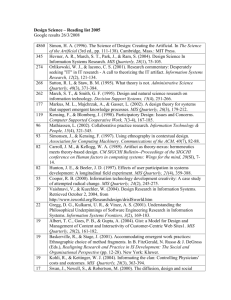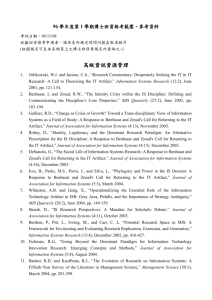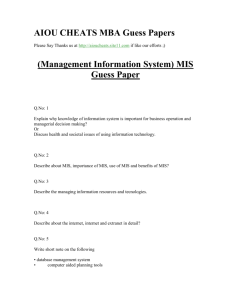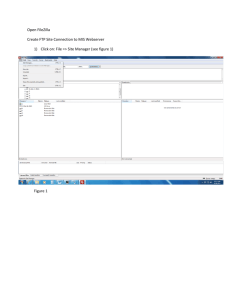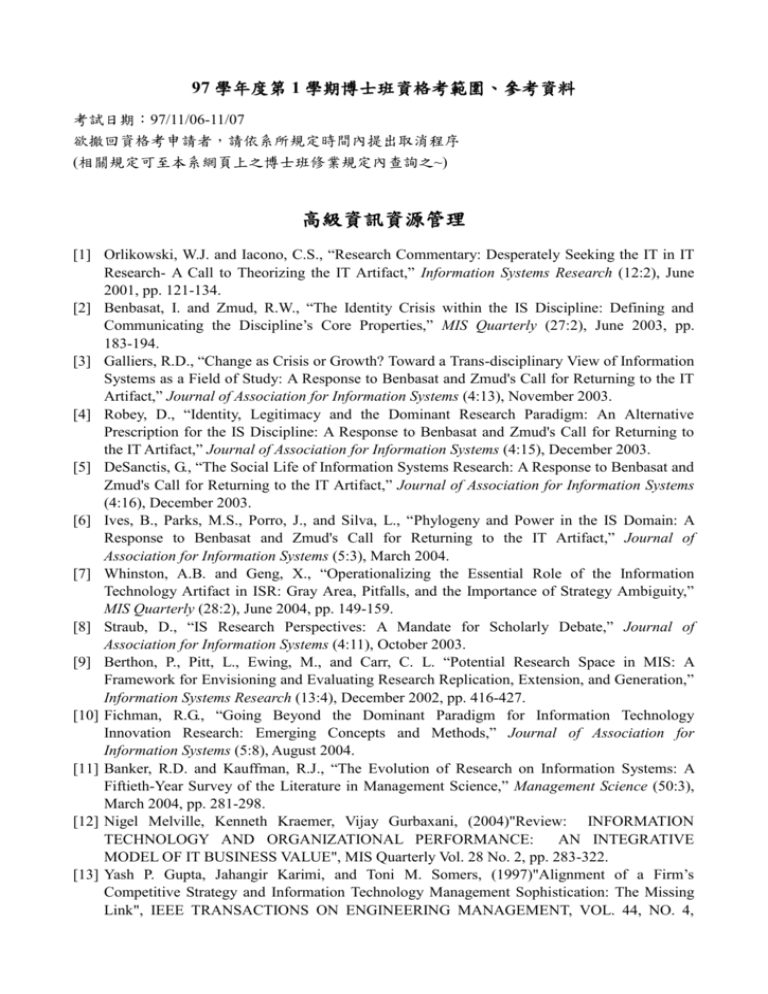
97 學年度第 1 學期博士班資格考範圍、參考資料
考試日期:97/11/06-11/07
欲撤回資格考申請者,請依系所規定時間內提出取消程序
(相關規定可至本系網頁上之博士班修業規定內查詢之~)
高級資訊資源管理
[1] Orlikowski, W.J. and Iacono, C.S., “Research Commentary: Desperately Seeking the IT in IT
Research- A Call to Theorizing the IT Artifact,” Information Systems Research (12:2), June
2001, pp. 121-134.
[2] Benbasat, I. and Zmud, R.W., “The Identity Crisis within the IS Discipline: Defining and
Communicating the Discipline’s Core Properties,” MIS Quarterly (27:2), June 2003, pp.
183-194.
[3] Galliers, R.D., “Change as Crisis or Growth? Toward a Trans-disciplinary View of Information
Systems as a Field of Study: A Response to Benbasat and Zmud's Call for Returning to the IT
Artifact,” Journal of Association for Information Systems (4:13), November 2003.
[4] Robey, D., “Identity, Legitimacy and the Dominant Research Paradigm: An Alternative
Prescription for the IS Discipline: A Response to Benbasat and Zmud's Call for Returning to
the IT Artifact,” Journal of Association for Information Systems (4:15), December 2003.
[5] DeSanctis, G., “The Social Life of Information Systems Research: A Response to Benbasat and
Zmud's Call for Returning to the IT Artifact,” Journal of Association for Information Systems
(4:16), December 2003.
[6] Ives, B., Parks, M.S., Porro, J., and Silva, L., “Phylogeny and Power in the IS Domain: A
Response to Benbasat and Zmud's Call for Returning to the IT Artifact,” Journal of
Association for Information Systems (5:3), March 2004.
[7] Whinston, A.B. and Geng, X., “Operationalizing the Essential Role of the Information
Technology Artifact in ISR: Gray Area, Pitfalls, and the Importance of Strategy Ambiguity,”
MIS Quarterly (28:2), June 2004, pp. 149-159.
[8] Straub, D., “IS Research Perspectives: A Mandate for Scholarly Debate,” Journal of
Association for Information Systems (4:11), October 2003.
[9] Berthon, P., Pitt, L., Ewing, M., and Carr, C. L. “Potential Research Space in MIS: A
Framework for Envisioning and Evaluating Research Replication, Extension, and Generation,”
Information Systems Research (13:4), December 2002, pp. 416-427.
[10] Fichman, R.G., “Going Beyond the Dominant Paradigm for Information Technology
Innovation Research: Emerging Concepts and Methods,” Journal of Association for
Information Systems (5:8), August 2004.
[11] Banker, R.D. and Kauffman, R.J., “The Evolution of Research on Information Systems: A
Fiftieth-Year Survey of the Literature in Management Science,” Management Science (50:3),
March 2004, pp. 281-298.
[12] Nigel Melville, Kenneth Kraemer, Vijay Gurbaxani, (2004)"Review: INFORMATION
TECHNOLOGY AND ORGANIZATIONAL PERFORMANCE:
AN INTEGRATIVE
MODEL OF IT BUSINESS VALUE", MIS Quarterly Vol. 28 No. 2, pp. 283-322.
[13] Yash P. Gupta, Jahangir Karimi, and Toni M. Somers, (1997)"Alignment of a Firm’s
Competitive Strategy and Information Technology Management Sophistication: The Missing
Link", IEEE TRANSACTIONS ON ENGINEERING MANAGEMENT, VOL. 44, NO. 4,
pp.399-412.
[14] Grover S. Kearnsa, Albert L. Ledererb, (2004) "The impact of industry contextual factors on IT
focus and the use of IT for competitive advantage", Information & Management, 41, 899–919.
[15] Sircar, S., Turnbow, J.L. and Bordoloi, B.(2000)"A framework for assessing the relationship
between information technology investiments and firm performance", JMIS, 16, 4, 69-97.
[16] Wegen, B.V. and Hoog, R.D.,(1996) "Measuring the economic value of information systems",
Journal of Information Technology, 11, 274-260.
[17] Davern, M.J. and Kauffman, R.J.,(2000) "Discovering Potential and Realizing Value form
Information Technology Investments," JMIS, 16, 4, 121-143.
[18] Hitt, L.M. and Brynjolfsson, E.(1996)"Productivity, Business profitability, and consumer
surplus: Three Different Measures of Information Technology value", MIS Quarterly, 20, 2,
pp.121-142
[19] Chan, Y.E., (2000)"IT Value: The Great Divide Between Qualitative and Quantitative and
Individual and Organizational Measures," Journal of Management Information Systems, 16, 4,
225-261.
[20] Tallon, P.P., Kraemer, K.K. and Gurbaxani, V., (2000) "Executives' perceptions of the Business
Value of Information Technology: A Process-Oriented Approach", JMIS, 16, 4, 145-173.
[21] Karimi, J., Gupta, Y.P. and Somers, T.M., (1996)"Impact of competitive strategy and
information technology maturity on firm's strategic response to globalization", JMIS, 12, 4,
55-88.
[22] Devaraj, S. and Kohli, R.(2000)"Information technology payoff in the Health-Care industry: a
longitudinal study", JMIS, 16, 4, 41-67.
[23] Wade, M. and Hulland, J. (2004)"REVIEW: THE RESOURCE-BASED VIEW AND
INFORMATION SYSTEMS RESEARCH: REVIEW, EXTENSION, AND SUGGESTIONS
FOR FUTURE RESEARCH1", MIS Quarterly Vol. 28 No. 1, pp. 107-142.
[24] Anandhi S Bharadwaj, (2000)"A resource-based perspective on information technology
capability and firm performance: An empirical investigation", MIS Quarterly, 24, 1,
pg.169-196.
[25] Mendelson, H. (2000), "Organizational architecture and success in the information technology
industry," Management Science, 46, 4, 513-529.
[26] Makadok, R. and Barney, J.B. (2001)"Strategic Factor Market Intelligence: An Application of
Information Economics to Strategy Formulation and Competitor Intelligence," Management
Science, 47, 12, 1621-1603.
[27] "Courtney, J.F.(2001) ""Decision making and knowledge management in inquiring
organizations: toward a new decision-making paradigm for DSS,"" Decision Support Systems ,
31, 17-38."
[28] Hess, T.J., Rees, L.P. and Rakes, T.R.(2000), "Using autonomous software agents to create
next generation of decision support systems," Decision Sciences, 31, 1, 1-31.
[29] Kearns, G.S. and Lederer, A.L. (2003) " A Resource-Based View of Strategic IT Alignment:
How Knowledge Sharing Creates Competitive Advantage," Decision Science, 34, 1, 1-29.
[30] Ranganathan, C. and Sethi, V.(2002) "Rationality in strategic information technology decisions:
The impact of shared domain knowledge and IT unit structure," Decision Science, 33, 1,
59-86.
[31] Shim, J.P., Warkentin, M., Courtney, J.F., Power, D.J., Sharda, R. and Carlsson, C. (2002)"Past,
present, and future of decision support technology," Decision Support Systems, 33, 111-126.
[32] Sarker, S., Valacich J.S., and Sarker, S. (2005) “Technology Adoption by Groups: A Valence
Perspective, ” Journal of the Association for Information Systems, 5, 2, pp.
[33] Fiona Fui-Hoon Nah and Izak Benbasat. (2004) "Knowledge-based Support in a Group
[34]
[35]
[36]
[37]
[38]
[39]
[40]
[41]
[42]
[43]
[44]
[45]
[46]
[47]
[48]
[49]
[50]
[51]
[52]
[53]
[54]
Decision Making Context: An Expert-Novice Comparison," Journal of the Association for
Information Systems, 5, 3, 125-150.
Mun Y. Yi, Yujong Hwang "Predicting the Use of Web-Based Information Systems:
Self-Efficacy, Enjoyment, Learning Goal Orientation, and The Technology Acceptance
Model," International Journal of Human-Computer Studies, 59, 4, pp.
Christina Finneran, Ping Zhang, "A Person-Artifact-Task (PAT) Model of Flow Antecedents in
Computer-Mediated Environments," International Journal of Human-Computer Studies, 59, 4,
pp.
Viswanath Venkatesh, Michael G Morris, Gordon B Davis, Fred D Davis, (2003) "User
acceptance of information technology: Toward a unified view1," MIS Quarterly, 27, 3,
425-474
Ajzan, I., (1991) " The Theory of Planned Behavior," Organizational Behavior and Human
Decision Processes, 50, 2, 179-211
Davis, F. D., (1989) "Perceived Usefulness, Perceived Ease of Use, and User Acceptance of
Information Technology," MIS Quarterly, 13, 3, 319-339.
Davis, F. D., Bagozzi, R. P., and Warshaw, P. R. (1989) "User Acceptance of Computer
Technology: A Comparison of Two Theoretical Models," Management Science, 35, 8,
982-1002.
Mathieson, K. (1991) "Predicting User Intentions: Comparing the Technology Acceptance
Model with the Theory of Planned Behavior," Information Systems Research, 2, 3, 173-191
Venkatesh, V., and Davis, F. D. (2000) "A Theoretical Extension of the Technology Acceptance
Model: Four Longitudinal Field Studies," Management Science, 45, 2, 186-204.
Mauricio S. Featherman, Paul A. Pavlou, "Predicting E-Services Adoption: A Perceived Risk
Facets Perspective," International Journal of Human-Computer Studies, 59, 4, pp.
Vessey I., (1991), Cognitive Fit: A theory-Based analysis of the Graphs versus Tables
Literature. Decision Sciences, Spring, 22, 2, 219-240.
Vessey, I. & D. Galletta, (1991), Cognitive Fit: an empirical study of Information Acquistion.
Information System Research, 2, 1, 63-84.
Dennis, A.R., and Carte, T.A., “Using Geographical Information Systems for Decision Making:
Extending Cognitive Fit Theory to Map-based Presentations," Information Systems Research,
Vol. 9, No. 2, 1998, pp. 194-203.
Goodhue, D.L., and Thompson, R.L.(1995) "Task-technology Fit and Individual Performance"
MIS Quarterly, 19, 2, 213-236.
Goodhue, D.L., "Development and Measurement Validity of a Task-Technology Fit Instrument
for User Evaluations of Information Systems” Decision science, Vol. 29, No. 1, 1998, pp.
105-137.
Massey, Anne p., Montoya-Weiss, M., Hung, Y.C. and V. Ramesh (2001). "Cultural
Perceptions of Task-Technology Fit" Communications of the ACM, 44, 12, 83-84
Hevner, A., March, S., Park, J. and Ram, S. (2004). "Design Science in Information Systems
Research" MIS Quarterly Vol. 28, No. 1, pp. 75-105.
March, S. and Smith, G. (1995). "Design and Natural Science Research on Information
Technology" Decision Support Systems, Vol. 15, pp. 251-266.
Walls, J., Widmeyer, G. and El Sawy, O. (1992). "Building an Information System Design
Theory for Vigilant EIS" Information Systems Research, Vol. 3, No. 1, pp. 36-59.
MISQ, JMIS, ISR 期刊,最近三年之文章及資訊資源管理相關經典理論。
Khosrowpour, M. Advanced Topics in Information Resources Management, Idea Group
Publishing, Hershey, PA, 2006.
McNurlin, B. C., and Sprague, R. H. JR. Information Systems Management in Practice,
Prentice Hall, Upper Saddle River, NJ, 2005.
[55] Turban, E., Leidner, D., McLean, E., and Wetherbe, J. Information Technology for
Management: Transforming Organizations in the Digital Economy, John Wiley & Sons,
Hoboken, NJ, 2008.
[56] Turban, E., King, D., Mckay, J., Marshall, P., Lee, J., Viehland, D. Electronic Commerce: A
Managerial Perspective, Pearson/Prentice Hall, Upper Saddle River, NJ, 2008.
高級企業資料通訊與網路
[1] Behrouz A. Forouzan, Data Communication and Networking, Fourth Edition, McGraw Hill,
International Edition 2007.
[2] Comupter Networks, by Andrew Tanenbaum, 4th Edition, Chapter 1~ 6
資訊科技與決策理論
[1] Holsapple, C. W. and A. B. Whinston. Decision Support Systems: A Knowledge Based Approach.
Minneapolis, MN: West Publishing, Inc., 1996.
[2] 最近五年 Decision Support Systems (Elsevier Science)期刊
[3] 最近三年 Decision Sciences (Decision Science Institute)期刊之相關文章
[4] Sprague R. H. and Watson H. J., (1996), Decision Support for Management, Prentice Hall.
[5] Efraim Turban, Jay Aronson, Ting-Peng Liang, Decision Support Systems and Intelligent
Systems, Seventh Edition, 2005, Peason Education, Inc., Upper Saddle River, New Jersey,
07458.
[6] Clyde Holsapple and Andrew Whinston, Decision Support Systems: A Knowledge-based
Approach, 1996 or 較新版, West Publishing Company, 610, Opperman Drive, St. Paul, MN,
55164.
軟體工程
[1] Sofware engineering, 8th edit. Sommerville, Addison-Wesley, and Object-oreiented & classical
software engineering, McGraw-Hill
[2] Roger S. PressMan, “Software Engineering: A Practitioner’s Approach”, 6th Edition PART 1,
PART2, PART 4.
[3] IT 成效最佳管理實務
The Effective Measurement and Management of IT Costs and Benefits (second edition)
[4] IEEE TRANSACTION ON SOFTWARE ENGINEERING 2001 JANUARY ~2006 AUGUST
電子化供應鏈管理
命題範圍:類似下列論文所牽涉之相關主題:
[1]
[2]
[3]
[4]
[5]
[6]
[7]
[8]
[9]
[10]
[11]
[12]
[13]
[14]
[15]
[16]
[17]
[18]
[19]
[20]
Russell, D. M. & Hoag, A. M. (2004). People and information technology in the supply chain:
Social and organizational influences on adoption. International Journal of Physical
Distribution & Logistics Management, 34(2), 102-122.
Ruppel, C. (2004). An information systems perspective of supply chain tool compatibility: the
roles of technology fit and relationships. Business Process Management Journal, 10(3),
311-324.
Groves, G. & Valsamakis, V. (1998). Supplier-Customer Relationships and Company
Performance. The International Journal of Logistics Management, 9(2), 51-64.
Premkumar, G. P. (2000). Interorganization systems and supply chain management: An
information processing perspective. Supply Chain Management, 56-69.
Wisner, J. D. (2003). A structural equation model of supply chain management strategies and
firm performance. Journal of Business Logistics, 24(1), 1-25.
Patterson, K. A., Grimm, C. M., & Corsi, T. M. (2003). Adopting new technologies for supply
chain management. Transportation Research Part E, 39, 95-121.
Stank, T. P. & Keller, S. B. (2001). Supply chain collaboration and logistical service
performance. Journal of Business Logistics, 22(1), 29-48.
chi-Levi, D., Kaminsky , P. & Simchi-Levi, E.,Designing & Managing The
Supply Chain,
3rd, 2008, McGraw Hill, NY.(華泰文化代理)
ESCM related articles from MIS Q, JMIS, and ISR for the past three years.
Bose, I.; Pal, R. and Ye, A. “ERP and SCM systems integration: The case of a valve
manufacturer in China,” Information & Management (45:4), June 2008, pp.233-241.
Byrd, T. A. and Davidson, N. W.(2003), “Examining possible antecedents of IT impact on the
supply chain and its effect on firm performance,” Information & Management, 41, pp.
243–255.
Chen, M. C.; Yang, T. and Li, H. C. “Evaluating the supply chain performance of IT-based
inter-enterprise collaboration,” Information & Management (44:6), September 2007,
pp.524-534.
Croom, S., Romano, P. and Giannakis, M.(2000), “Supply chain management: an analytical
framework for critical literature review,” European Journal of Purchasing & Supply
Management, 6, pp. 67-83
Frohlich, M.(2002), “e-Intergration in the Supply Chain: Barriers and Performance,” Decision
Sciences, 33(4), pp. 537-556
Gunasekaran, A.and Ngai, E.W.T.(2004), “Information systems in supply chain integration
and management,” European Journal of Operational Research, 159, pp. 269–295
Harrison, T. and Waite, K. “A time-based assessment of the influences, uses and benefits of
intermediary website adoption,” Information & Management (43:8), December 2006,
pp.1002-1013.
Kuk, G.(2004), “Effectiveness of vendor-managed inventory in the lectronics industry:
determinants and outcomes,” Information & Management, 41, pp. 645–654
Kulp, S. C., Lee, H. L. and Ofek, E.(2004), “Manufacturer Benefits from Information
Integration with Retail Customers,” Management Science, 50(4), pp. 431-444
Kumar, K. and van Dissel, H. G.(1996), “Sustainable collaboration: Managing conflict and
cooperation in interorganizational Systems,” MIS Quarterly, 20(3), pp. 279-300
Kwon, I. G., Suh, T.(2004), “Factors Affecting the Level of Trust and Commitment in Supply
Chain Relationship,” Journal of Supply Chain Management, 40(2), pp. 4-14
[21] Lai, K. H.; Wong, C. W. Y. and Cheng, T. C. E. “A coordination-theoretic investigation of the
impact of electronic integration on logistics performance,” Information & Management (45:1),
January 2008, pp.10-20.
[22] Lim, D. and Palvia, P. C.(2001), “EDI in strategic supply chain: impact on customer service,”
International Journal of Information Management, 21, pp. 193–211
[23] Mishra, B. K. and Raghunathan, S.(2004), “Retailer- vs. Vendor-Managed Inventory and
Brand Competition,” Management Science, 50(4), pp. 445-457
[24] Narasimhan, R. and Kim S. W.(2001),”Information system utilization strategy for supply
chain integration,” Journal of Business Logistics, 22, pp. 51-75
[25] Pant, S., Sethi, R. and Bhandari, M.(2003), “Making sense of the e-supply chain landscape: an
implementation framework,” International Journal of Information Management, 23, pp.
201–221
[26] Patterson, K. A., Grimm, C. M. and Corsi, T. M.(2003), ”Adopting new technologies for
supply chain management,” Transportation Research Part E, 39, pp. 95–121
[27] Rahman, Z.(2003),” Internet-based supply chain management: using the Internet to
revolutionize your business,” International Journal of Information Management, 23, pp.
493–505
[28] Ruppel, C.(2004), “An information systems perspective of supply chain tool compatibility: the
roles of technology fit and relationships,” Business Process Management Journal,10(3), pp.
311-324
[29] Subramani, M.(2004), “How Do Suppliers Benefit from Information Technology Use in
Supply Chain Relationship,” MIS Quarterly, 28(1), pp. 46-73
[30] Swaminathan, J. M. and Tayur, S. R. (2003), “Models for Supply Chains in E-Business,”
Management Science, 49(10), pp. 1387-1406
[31] White, A., Daniel, E.M. and Mohdzain, M.(2005), “The role of emergent information
technologies and systems in enabling supply chain agility,” International Journal of
Information Management, 25, pp. 396–410
[32] Winser, J. D.(2003), “A Structural Equation Model of Supply Chain Management Strategies
and Firm Performance,” Journal of Business Logistics, 24(1), pp. 1-25
[33] Zhao, X., Xie, J. and Zhang, W.(2002), “The impact of information sharing and ordering
co-ordination on supply chain Performance,” Supply Chain Management, 7(1), pp. 24-40
電子商務與應用
[1]
[2]
[3]
[4]
[5]
[6]
[7]
[8]
[9]
[10]
[11]
[12]
[13]
[14]
[15]
[16]
[17]
[18]
[19]
[20]
International Journal of Electronic Commerce2003-2008 相關電子商務主題。
E. Turban et al. (2007), "Electronic Commerce: A Managerial Perspective",華泰書局出版。
J. Rayport and B. Jaworski, "Introduction to e-commerce",Second edition,高立圖書公司
Turban, E., King, D., Viehland., Lee, J. Electronic Commerce: A Managerial Perspective,
Pearson, Upper Saddle River, NJ, 2006.
Turban, E., Leidner, D., McLean, E., and Wetherbe, J. Information Technology for
Management: Transforming Organizations in the Digital Economy, John Wiley & Sons, New
York, NY, 2006.
Articles from MIS Q, JMIS, and ISR for the past three years.
Kuan, H.-H., Bock, G.-W.(2007), “Trust transference in brick and click retailers: An
investigation of the before-online-visit phase,” Information & Management, 44(2), pp.
175-187
Ozer, M.(2005). “Online business: tailoring your business environment in order to compete,”
International Journal of Information Management, 25(2), pp. 137-149
Chang, M. K., Cheung, W., and Lai, V. S.(2005), “Literature derived reference models for the
adoption of online shopping,” Information & Management, 42(4), pp. 543-559
Lim, K. H., Sia, C. L., Lee, M. K. O., and Benbasat, I.(2006), “Do I Trust You Online, and If
So, Will I Buy? An Empirical Study of Two Trust-Building Strategies,” Journal of
Management Information Systems, 23(2), pp. 233-266
Lin, H.-H., Wang, Y.-S.(2006), “An examination of the determinants of customer loyalty in
mobile commerce contexts,” Information & Management, 43(3), pp. 271-282
Wade, M. R., Nevo, S.(2005-6), “Development and Validation of a Perceptual Instrument to
Measure E-Commerce Performance,” International Journal of Electronic Commerce, 10(2), pp.
123-146
Dinev, T., Hart, P.(2006), “An Extended Privacy Calculus Model for E-Commerce
Transactions,” Information Systems Research, 17(1), pp. 61-80
Venkatesh, V., Agarwal, R.(2006), “Turning Visitors into Customers: A Usability-Centric
Perspective on Purchase Behavior in Electronic Channels,” Management Science, 52(3), pp.
367-382
Dinev, T., and Hart, P.(2005-6), “Internet Privacy Concerns and Social Awareness as
Determinants of Intention to Transact,” International Journal of Electronic Commerce, 10(2),
pp. 7-29
Pavlou, P. A., Liang, H., and Xue, Y.(2007), “Understanding and Mitigating Uncertainty in
Online Exchange Relationships: a Principal--Agent Perspective,” MIS Quarterly, 31(1),pp.
105-136
Zhu, K., Kraemer, K. L.(2005), “Post-Adoption Variations in Usage and Value of E-Business
by Organizations: Cross-Country Evidence from the Retail Industry,” Information Systems
Research, 16(1), pp. 61-84
Komiak, S., and Benbasat, I.(2006), “The Effects of Personalization and Familiarity on Trust
and Adoption of Recommendation Agents,” MIS Quarterly, 30(4), pp. 941-96
Ethier, J., Hadaya, P., Talbot, J., and Cadieus, J.(2006), “B2C web site quality and emotions
during online shopping episodes: An empirical study,” Information & Management, 43(5), pp.
627-639
Wujin, C., Choi, B., and Song, M. R.(2005), “The Role of On-line Retailer Brand and
Infomediary Reputation in Increasing Consumer Purchase Intention,” International Journal of
Electronic Commerce, 9(3), pp. 115-127
[21] Zhuang, Y., Lederer, A. L.(2005), “A resource-based view of electronic commerce,”
Information & Management, 43(2), pp. 251-261
顧客關係與管理
命題範圍:下列書籍與主題相關之期刊論文
[1]
[2]
[3]
[4]
[5]
[6]
[7]
[8]
[9]
[10]
[11]
[12]
[13]
[14]
[15]
[16]
[17]
[18]
[19]
Stanley Brown, Customer Relationship Management: A Strategic Imperative in the World of
e-Business, 2000, John Wiley & Sons Canada Limited, 22 Worcester Road, Etobicoke,
Ontario.
V. Kumar and Werner, Reinartz, Customer Relationship Management : A Databased Approach,
2006, John Wiley & sons, Inc.
Michael Berry and Gordon Linoff, Data Mining Techniques: For Marketing, Sale, and
Customer Relationship Management, 2004, Wiley Publishing, Inc.
主題:
1. Relationship Marketing Literature Discussion
2. CRM and Loyalty Literature Discussion
3. CRM & New Product Literature Discussion
4. CRM & e-Channel Literature Discussion
5. Knowledge Management Literature Discussion
Journal of Marketing 2005-2008 相關論文
International Journal of Electronic Commerce2005-2008 相關論文
CRM related articles from MIS Q, JMIS, and ISR for the past three years.
Boulding, W.; Staelin, R.; Ehret, M and Johnston, W.J.(2005), “A Customer Relationship
Management Roadmap: What Is Known, Potential Pitfalls, and Where to Go,” Journal of
Marketing, 69, pp. 155–166.
Payne, A. and Frow, P.(2005), “A Strategic Framework for Customer Relationship
Management,” Journal of Marketing, 69, pp. 167-176.
Padmanabhan, B.; Zheng, Z. and Kimbrough, S.O.(2007), “An emperical analysis of the value
of complete information for eCRM models,” MIS Quarterly, 30, pp. 247-267.
Oyvind, H.(2006), “Are Loyal Customers Profitable? Customer Satisfaction, Customer
(Action) Loyalty and Customer Profitability at the Individual Level,” Journal of Marketing
Management, 22, pp. 245-266.
Kumar, V. and Shah, D.(2004),“Building and sustaining profitable customer loyalty for the
21st century,” Journal of Retailing, 80, pp. 317–330.
Lewis, M.(2006), “Customer Acquisition Promotions and Customer Asset Value,” Journal of
Marketing Research, 43, pp. 195-203.
Anderson, J.L.; Jolly, L.D. and Fairhurst, N.E.( 2007), “Customer relationship management in
retailing: A content analysis of retail trade journals,” Journal of Retailing and Consumer
Services , 14, pp. 394–399.
Richards, K.A. and Jones, E.(2008), “Customer relationship management: Finding value
drivers,” Industrial Marketing Management, 37, pp. 120–130.
Bose, R.(2002), “Customer relationship management: Key components for IT success,”
Industrial Management & Data System, 102, pp. 89-97.
Coyles, S. and Gokey, T.C.( 2005), “Customer retention is not enough,” The Journal of
Consumer Marketing , 22, pp. 101-105.
Eriksson, K and Vaghult, A.L.(2000), “Customer Retention, Purchasing Behavior and
Relationship Substance in Professional Services,” Industrial Marketing Management, 29, pp.
363–372.
Lemon, K.N.; White, T.B. and Winer, R.S.(2002), “Dynamic customer relationship
management: Incorporating future considerations into the service retention decision,” Journal
of Marketing, 66, pp.1-14.
[20] Wilson, H., Daniel, E., & McDonald, M.(2002), “Factors for success in customer relationship
management (CRM) systems,” Journal of Marketing Management, 18, pp. 193−219.
[21] Karimi, J.; Somers, T.M. and Gupta, Y.P.(2001), “Impact of information technology
management practice on customer service,” Jaumal of Management Inoformation Systems,
17, pp. 125-158.
[22] Wulf, K.D.; Schroder G.O. and Lacobucci, D.(2001), “Investments in consumer relationships:
A cross-country and cross-industry exploration,” Journal of Marketing, 65, pp. 33-51.
[23] Plessisa, M. D. and Boonb, J.A.(2004), “Knowledge management in eBusiness and customer
relationship management: South African case study findings,” International Journal of
Information Management ,24, pp. 73–86.
[24] BOWMAN, D. and NARAYANDAS, D.(2004), ” Linking Customer Management Effort to
Customer Profitability in Business Markets,” Journal of Marketing Research, 41, pp. 433–447.
[25] Lynette, R.(2005),” Making Customer Relationship Management Work: The Measurement
and Profitable Management of Customer Relationships,” Journal of Marketing (69:4), 69, pp.
252-261.
[26] Lawrence, A. and Francis, B.(2006), “Managing For Successful Customer Acquisition: An
Exploration,” Journal of Marketing Management, 22, pp. 295-317.
[27] Ryals, L. and Knox, S.(2007), “Measuring and managing customer relationship risk in
business markets,” Industrial Marketing Management, 36, pp. 823-833.
[28] JACQUELYN, S.T.; ROBERT, C.B. and EDWARD, J.F.(2004), “Recapturing Lost
Customers,” Journal of Marketing Research ,41, pp. 31–45.
[29] Chiu, H.C.; Hsieh, Y.C.; Li, Y.C. and Lee, M.(2005), “Relationship marketing and consumer
switching behavior,” Journal of Business Research,58, pp. 1681– 1689.
[30] Roberts, M.L.; Liu, R.R. and Hazard, K.(2005), “Strategy, technology and organisational
alignment: Key components of CRM success,” Database Marketing & Customer Strategy
Management, 12, pp. 315–326.
[31] Sheth, J. N.; Sisodia, R. and Sharma, A.(2000), “The antecedents and consequences of
customer-centric marketing,” Journal of the Academy of Marketing Science, 28, pp. 55−56.
[32] Minami, C. and Dawson, J.(2008), “The CRM process in retail and service sector firms in
Japan: Loyalty development and financial return,” Journal of Retailing and Consumer
Services , 15, pp. 375–385.
[33] Reinartz, W.; Krafft, M. and Hoyer, W.D.(2004), “The Customer Relationship Management
Process: Its Measurement and Impact on Performance,” Journal of Marketing Research, 41, pp.
293–305.
[34] Tokman, M.; Davis, L.M. and Lemon, K. N.( 2007), “The WOW factor: Creating value
through win-back offers to reacquire lost customers,” Journal of Retailing, 83, pp. 47–64.
[35] Gounaris, S.P.(2005), “Trust and commitment influences on customer retention:insights from
business-to-business services,” Journal of Business Research, 58, pp. 126– 140.
[36] King, S.F. and Burgess, T.F.(2008), “Understanding success and failure in customer
relationship management,” Industrial Marketing Management, 37, pp. 315–326.
[37] Verhoef, P.C.(2003), “Understanding the effect of customer relationship management efforts
on customer retention and customer share development,” Journal of Marketing, 67, pp. 30−45.
策略與資訊管理
[1]
[2]
[3]
[4]
[5]
[6]
Michael Porter, Competitive Advantage: Creating and Sustaining Superior Performance, 1985,
The Free Press, A Division of Macmillan, Inc., New York, N.Y.
2. Seev Neumann, Strategic Information Systems: Competition Through Information
Technologies, 1994, Macmillan College Publishing Company, New York, N.Y.
Mata, F. J., W. L. Fuerst and J. B. Barney, (1995), “Information Technology and Sustained
Competitive Advantage: A Resource-Based Analysis,” MIS Quarterly, (December),
pp.487-505.
Barney, J., (1991), “Firm resources and sustained competitive advantage,” Journal of
Management, 17(1), pp.99-120.
Ross, J. W., C. M. Beath and D. L. Goodhue, (1996), “Develop Long-Term Competitiveness
through IT Assets,” Sloan Management Review, Fall, pp.31-42.
競爭策略(Michael E. Porter)
平衡計分卡(Kaplan & Norton)

